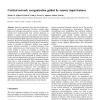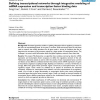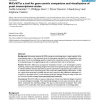1029 search results - page 202 / 206 » Dependence Anti Patterns |
BC
2002
13 years 7 months ago
2002
Abstract. Sensory experience alters the functional organization of cortical networks. Previous studies using behavioral training motivated by aversive or rewarding stimuli have dem...
BMCBI
2004
13 years 7 months ago
2004
Background: Hidden Markov Models (HMMs) have proven very useful in computational biology for such applications as sequence pattern matching, gene-finding, and structure prediction...
BMCBI
2004
13 years 7 months ago
2004
Background: Several aspects of microarray data analysis are dependent on identification of genes expressed at or near the limits of detection. For example, regression-based normal...
BMCBI
2004
13 years 7 months ago
2004
Background: Functional genomics studies are yielding information about regulatory processes in the cell at an unprecedented scale. In the yeast S. cerevisiae, DNA microarrays have...
BMCBI
2004
13 years 7 months ago
2004
Background: Information obtained by DNA microarray technology gives a rough snapshot of the transcriptome state, i.e., the expression level of all the genes expressed in a cell po...



